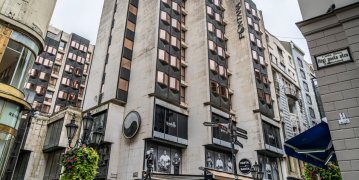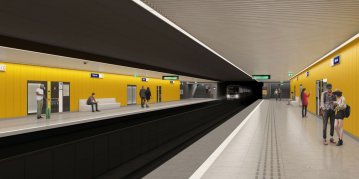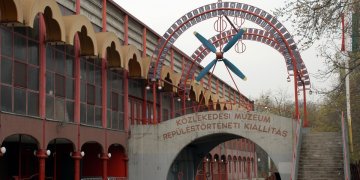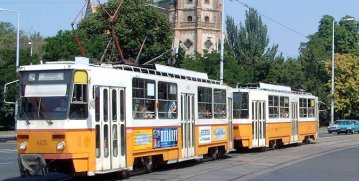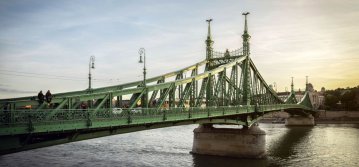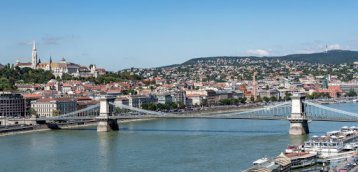 The „intertwined history” of the bridges and the city of Budapest
Which ideas and events have shaped the fate of bridges of Budapest and the cityscape? Alongside many other interesting facts, this question is also answered this newly published book by the Budapest City Archives, which introduces the history of bridges in Budapest.
The „intertwined history” of the bridges and the city of Budapest
Which ideas and events have shaped the fate of bridges of Budapest and the cityscape? Alongside many other interesting facts, this question is also answered this newly published book by the Budapest City Archives, which introduces the history of bridges in Budapest.
Search result
Ice skating rink to be built on Kapisztrán Square
November 8, 2020 at 5:30 PM
A new ice skating rink is to be built in Buda, within the castle walls in front of the local mayor's office. Parking on the square will be suspended.
Ten stunning domes lost from the Budapest cityscape
November 8, 2020 at 10:00 AM
Following a recent decision reached by the government, the domes and roof ornaments of buildings may be reconstructed around the country. The first three will be completed within a pilot project in Budapest. This list from Pestbuda collects ten buildings that were once famous for their roofs and which we believe should be among the first to be replaced.
Renovation work on central section of M3 begins
November 7, 2020 at 9:00 AM
The renovation of the M3 metro line will continue from 7 November. Trains will not serve Stations between Lehel Square and Nagyvárad Square. Changes to urban traffic and public transport are planned to be in place for one and a half years.
First section of Pest's intertwining tram network completed
November 6, 2020 at 2:00 PM
The first section of the Pest tram network development has been completed in Ferencváros. The development will support diversion efforts during the renovation of Metro line M3, as the 2M tram will provide a direct connection between Nagyvárad Square and the city centre.
Sixty years of articulated buses in Budapest
November 6, 2020 at 9:00 AM
There were not enough buses in the Budapest of the 1950s, and those that were in use were too small. Decision-makers expected a quick solution from Ikarus but the Hungarian bus manufacturer only promised to offer a large articulated bus in the middle of the 1960s. The Budapest bus workshop was unwilling to wait. They built over 300 articulated buses themselves.
Original ornaments returned to Bull Statue in Újbuda
November 5, 2020 at 5:00 PM
The statue entitled Monda ('myth') in Bikás ('bull') Park has been restored. The original ornaments symbolising the Sun, Moon and Starts above the heads of the bulls have been replaced.
The decorators of the palace built for the Ministry of Finance
November 5, 2020 at 9:00 AM
Passers-by are often in awe of the stunning decorations and ornaments that characterise the era of historicism. The palace of the Ministry of Finance on Szentháromság Square is another building on which several masters worked, take a look at their work.
New tourism and marketing organization of Budapest created
November 4, 2020 at 5:00 PM
Budapest Brand, the capital's new tourism and marketing organisation, is now responsible for managing Budapest's marketing strategy, creating cultural content, organising festivals and fairs. The organisation's goal is to convey the image of a livable and lovable city.
45 years under ground – A museum on Deák Square about the Millennium underground Railway
November 4, 2020 at 3:00 PM
A museum housed in an abandoned underground tunnel, filled with original rolling-stock, and a slew of objects from the history of one the world's oldest underground railways. All of this for the price of a single ticket in the middle of the city, under Deák Square. The Millennium Underground Museum opened 45 years ago.
A forgotten house – The origins of Eötvös József College
November 4, 2020 at 9:00 AM
A small street near Kálvin Square bears the name of Pál Gönczy, a writer on educational subjects and teacher at the Reformed Secondary School of Pest. In 1895 a small teacher training institute named after Gönczi's former ministerial superior, Count József Eötvös was opened here. At the time it was known as Csillag Street. Loránd Eötvös founded the College, and its first headteacher was Géza Bartoniek. They are the protagonists of the first 15 years of institution's history, but the small building where early students worked with their professors until 1911, was forgotten.
The Hungarian Academy of Sciences turns 195
November 3, 2020 at 5:30 PM
The imposing main building of the Hungarian Academy of Sciences stands on Széchenyi Square. The institution was founded after almost 100 years of proposals, planning and negotiations. Eventually, a 34-year-old Hussar Captain donated the money needed to create it, 195 years ago.
Next section of Andrássy Avenue to be renovated – 4,500 new plants planned
November 3, 2020 at 3:00 PM
Gardening works started yesterday along Andrássy Avenue. A total of 4,500 perennial plants and 16 new trees will be planted between Oktogon and Vörösmarty Street.
Three US Presidents remembered in Budapest
November 3, 2020 at 9:00 AM
The United States is electing a new president. As the world follows events across the Atlantic, take a stroll through the US-related buildings and monuments in Budapest.
Excavation of the Great Synagogue in Buda Castle to begin
November 2, 2020 at 4:00 PM
Preparations for the excavation of the Great Synagogue of Buda Castle are underway near 21–23 Táncsics Street. A synagogue was among Europe's largest Jewish halls of worship and was built during the reign of King Matthias and stood until 1686. Beyond preservation, the excavation hopes to ensure visitation to the runes.
Buried in Budapest – Great Hungarian figures born beyond the modern borders of Hungary lie in the Fiumei Road Cemetery
November 2, 2020 at 9:00 AM
The number of those born beyond Hungary's present borders but buried in Budapest is almost unfathomable. Among them several well-known and respected figures. The reason is obvious, talented and ambitious youths gravitated to Budapest from all over the country before 1920, just as they do today. Many of them completed their life's work in Budapest. Walking through the Fiumei Road Cemetery one quickly realises how many great Hungarian figures were born outside of the nation's post-Trianon borders. The compilation honours their memory.
Lost to war – Domes and ornaments lost during or after World War II to be restored throughout Hungary
November 1, 2020 at 11:00 AM
Three major Budapest buildings will be the first to have their domes and decorations reconstructed within a pilot project. Following in its footsteps, the government hopes to begin a national initiative to restore the domes and ornaments lost in the Second World War or torn down during earlier reconstruction efforts. Plans also include provisions to provide incentives for the restoration of privately owned buildings as well.
A new Margit Boulevard in the works – Cultural district planned in 2nd District
October 31, 2020 at 2:00 PM
The 2nd District local council is looking to redefine Margit Boulevard as a cultural centre to repopularise the one lively area of the city. Architects and local businesses are involved in the planning process.
A glance into the past – Budapest in 1990
October 31, 2020 at 9:00 AM
For those who have always lived in Budapest, the changes of the last thirty years may not be obvious, the buildings lost and built every little change. Some may not even remember what was on people's minds during the fall of communism, or even just how everyday life happened. On the thirtieth anniversary after the creation of the democratic Budapest Local Council take a glance back in time with PestBuda.
Imre Francsek – Lesser known architect behind City Park Skating Rink died 100 years ago
October 30, 2020 at 11:00 AM
The architect behind the ice skating rink in City Park, the colonnade of the Saint Gerard statue, the Buda Civic Casino and several residential buildings. If all his plans had been carried out, Calvin Square and Szabadság Square would be very different. At one point in his career, he even proposed pushing the entire Dreher Palace a few metres to the side. Imre Francsek died one hundred years ago.
The memento of a World Fair never held – Rákóczi Bridge turns 25
October 29, 2020 at 9:00 AM
Budapest's first permanent urban bridge built since the end of World War II was completed 25 years ago after 30 different plans were drawn up and 20 years of preparation. It was not welcomed unanimously by Budapest's residents, and the world fair that had been the reason behind its location was never held.
Public survey being conducted regarding souther railway development
October 28, 2020 at 4:00 PM
Two new tracks will be built alongside the existing two lines between Népliget and Kelenföld. The development of the southern ring railway would allow trains to run three times more frequently and provide a great connection to three metro lines (M3, M4, and M5 which will be created by connecting suburban railway lines). Residents of the area are requested to respond to the survey and can find more information on a new website dedicated to the project.
A forerunner of modern Hungarian architecture – Remembering Béla Lajta
October 28, 2020 at 9:00 AM
Lajta Béla was one of the most influential Hungarian architects of the first decades of the 20th century. Starting in the footsteps of Ödön Lechner, his art nouveau style grew into a new form and became a forerunner of Hungarian modern architecture. He represented a new approach to the formation of mass while retaining folk-based decorations and the ornamentation of art nouveau, and he connected it to new materials and designed buildings which were monumental in their simplicity. Buildings that have remained beautiful examples of modern urban architecture to the present day.
Statue of George Bush unveiled on Szabadság Square
October 27, 2020 at 2:30 PM
Statue of George H. W. Bush., 41st President of the United States of America, has been unveiled on Szabadság Square. The bronze full-length work was erected alongside a statue of Ronald Reagan.
Pest to Buda, from Buda to Pest – 150 years of the Hungarian Supreme Audit Office
October 27, 2020 at 11:30 AM
The Supreme Audit Office of Hungary (SAO) operates in a special building. Its headquarters are among the few buildings on the bank of the Danube that were not destroyed in the Second World War. However, the building displayed on the commemorative coin on the 150th anniversary is not its current headquarters. The institution's former building was constructed before World War I on the Buda side of the River and designed by Lajos Jámbor and Zoltán Bálint.
Tram line along the Danube – Tracks on Pest embankment opened 120 years ago
October 26, 2020 at 4:30 PM
The section of the tram tracks between the Hungarian Academy of Sciences and Erzsébet Bridge was opened on 20 October 1900, 120 years ago.
Jump over to Sugár – Forty years of an iconic shopping centre
October 26, 2020 at 12:00 PM
The socialist shopping centre opened on örs Vezér Square forty years ago. While Terminal originally one the contest announced to find a name, the city council eventually named the 29-thousand square metre shopping centre Sugár. Filled with the state-owned shops of the era the store brought several novelties. Home delivery could be requested on certain items, pre-orders could be placed, and the upper floors were wheel-chair accessible. The hit slogan, Csak egy ugrás a Sugár (loosely, 'jump over to Sugár') became the iconic phrase of a generation.
Szent Angéla School on Rózsadomb to be expanded
October 25, 2020 at 3:00 PM
Szent Angéla School in the 2nd District is being renovated and expanded. A new community room, a science wing, and a new library are being created.
First renovated spire of Western Railway Station completed
October 24, 2020 at 5:00 PM
Renovation of the 8,200 square metre roof of Nyugati Pályaudvar, the Western Railway Station has reached a spectacular stage. The first of the spires for the towers on the rear facade has been raised into place. Meanwhile, the new glass panels of the roof are being installed, and the roof structures of the towers on the main facade toward Teréz Boulevard are being removed.
A modern cinema for Buda – Atrium Movie Theatre completed 85 years ago
October 24, 2020 at 3:00 PM
Átrium was a unique cinema in every respect. It differed from the others in Budapest not only because of its modern building but also in how it was operated. The elegant new auditorium seated 800 people and offered a new quality in both sound and elegance when opened in 1935.
Bust of Ilona Tóth unveiled in courtyard of Bajcsy-Zsilinszky Hospital
October 22, 2020 at 5:00 PM
Ilona Tóth was a final year medical student who was an extern during the 1956 revolution became a symbolic figure of the communist regime's retaliation for the revolution. A new bust commemorating her has been unveiled in the courtyard of the Bajcsy-Zsilinszky Clinic and Hospital in Kőbánya.
Budapest and love
October 22, 2020 at 2:00 PM
A small collection of poems from Hungarian poets was published recently. Naturally, it is connected to Budapest. The pages of the booklet are decorated with pictures of statues found around Budapest.
Renovated Bulgarian Orthodox Church of Ferencváros opened
October 22, 2020 at 10:00 AM
The renovated Bulgarian Orthodox Church of Saints Cyril and Methodius on Vágóhír Road in the 9th District has been inaugurated. During the ceremony a memorial to the Metropolitan Boris of Nevkropov who was martyred in Communist Bulgaria. The high priest of Bulgaria visited Budapest in 1931 and participated in laying the foundation stone of the church.
Fontana house to be torn down – New construction project begins in city centre
October 21, 2020 at 4:00 PM
Fontana House on the corner of Véáci Street and Régi Posta Street, built in 1984 is to be torn down to make way for a new modern building with commercial areas on its ground floor and housing above.
Southern section of M3 to open on Thursday – Full-line service for two weeks
October 21, 2020 at 9:30 AM
Trains will run the entire length of the M3 metro line for two weeks until 6 November. On 7 November renovation of the central section between Nagyvárad tér and Lehel tér stations will begin.
Exhibition of aerospace history opened in Petőfi Csarnok 35 years ago
October 20, 2020 at 9:00 AM
The upper floor of the Petőfi Csarnok housed the Aviation and Space Exploration exhibit of the Transport Museum for thirty years. The aeroplane used by Charles IV in his attempt to return to the Hungarian throne in 1909 and was on display, as was the World war I reconnaissance aircraft manufactured by the Lloyd factory in Aszód. Relics of the space age included the crew capsule used by Bertalan Farkas and Valeri Kubasov to return to Earth from the Salyut-6 space station. When the Petőfi Csarnok was closed, the exhibition was also forced to leave.
All Tátra trams now equipped to transport bicycles
October 19, 2020 at 5:00 PM
Cyclists will be able to board nearly one-third of all trams in Budapest with their bicycles from 17 October.
The future of Római Part – Suggestions welcome!
October 19, 2020 at 2:00 PM
The Budapest City Council is accepting opinions and ideas regarding the future of Római-part. Hospitality providers and sports clubs in the area are also being involved in the planning process.
Stunning decorations line the Renaissance-revival palace of the Main Customs House
October 19, 2020 at 9:00 AM
The Main Customs House building, which today houses Corvinus University is a major sight in Budapest. The façade is decorated by 22 statues of figures from Greek-Roman mythology and traditional Hungarian crafts. The main courtyards, staircases, the internal and external decorations all highlight just how great a masterpiece the building is. Construction of the building began 150 years ago in 1870, according to plans drawn up by one of the greatest Hungarian architects, Miklós Ybl.
After 77 years a new Secondary School of the Reformed Church is opened in Budapest
October 18, 2020 at 10:00 AM
The new building complex of the Rózsakerti Demjén István Reformed Primary and Secondary School in the 22nd District was inaugurated through a thanksgiving service, with Viktor Orbán, prime minister, attending. A belfry was also built alongside the school. The bell is decorated with a map of historical Hungary to symbolise the unity of the Hungarian people. The event is made al the more significant by the fact that the last new Reformed Secondary School built in the capital was opened in 1943, 77 years ago on Lónyay Street in the 9th District.
An old wooden cross made anew on 13th-district Diana Street
October 17, 2020 at 3:00 PM
The wooden cross at the intersection of Diana and Gyöngyvirág Streets in the 13th District has been renovated. The crucifix that originally stood here was demolished in the 1950s but rebuilt in 2008.
Green Liberty – The decision to repaint Szabadság Bridge to its original green was reached 35 years ago
October 17, 2020 at 11:00 AM
Following a tragedy in Vienna, abridge renovation project was launched in Budapest in 1979. Szabadság Bridge was slated for renovation in 1981, however, was eventually prioritised due to urgent work. Despite this, the bridge was closed again in 1985, as the original steel support columns had been corroded so significantly they became unstable. However, during this second renovation, the decision to repaint the bridge to its original green was also made.
New information boards to help visitors at the most crowded points of Buda Castle
October 16, 2020 at 7:00 PM
A total of ten new information boards have been set up in Buda Castle at locations such as the renovated Matthias Fountain, the Savoyai Terrace, the Raven Gate, and Szent György ('Saint Geroge') Square and the Maria lift.
Joyous I do's – 125 years of civil marriage in Budapest
October 16, 2020 at 1:00 PM
Laws on state registries and civil marriage were passed in 1894 but only entered into force a year later on 1 October 1895. The novelty of the now everyday ceremony caused such a rush that the three registrars in Budapest at the turn of the century could barely cope with the number of marriage requests. Where and how did the first civil marriage in Hungary unfold?
Government set to take over Budapest development efforts
October 16, 2020 at 10:00 AM
The government would prefer to take over development projects towards which the City Council has requested 55 billion HUF from the state. The plan was revealed as yesterday's sitting of the Budapest Public Works Council. The projects in question include the Biodome and the funicular planner for Gellért Hill. An agreement is yet to be reached regarding these plans. However, the government is already set to take over the development of the H2 suburban railway line to Gödöllő, and its connection to the M3 metro. The extension of the Buda tram network on Műegyetem Embankment is also to be funded by the state. The government has also blocked the city's plans to take a loan from the European Development Bank and the introduction of the so-called restart tax. The 6 billion HUF needed for the renovation of Chain Bridge will be transferred to the city when all other funds required for the project have been secured.
Southern section of M3 metro line to be opened on 22 October
October 15, 2020 at 7:30 PM
Renovation of the section began in April 2019 and was completed recently. Four stations of the line have been rebuilt. Its tunnels renewed, the track network, signals and safety systems modernised, alongside passenger information and other electrical systems. The renovated metro section will be opened to the public at 5 pm on 22 October. Following the opening the metro will again run the full length of the line but not stop at its central stations: Semmelweis klinikák, Corvin Negyed, Ferenciek tere and Arany János utca.
Defined by Ybl and Lechner
October 15, 2020 at 6:00 PM
When asked to name Hungarian architects, most people will likely mention Miklós Ybl and Ödön Lechner. This is no coincidence; the two architects were prolific and important artists is their age. But how much do people know about their time and their contemporaries? The new volume Ylb és Lechner vonzásában provides information on these.
A Székely gate on Sas Hill
October 15, 2020 at 12:00 PM
István Benedek, the renowned 20th-century writer, doctor, psychiatrist and public figure was the son of the great Székely storyteller Elek Benedek, and both of them remain household names in many Hungarian families to the present day. Beyond his books, István Benedek is memorialised by a Székely gate that he carves himself, and erected before the villa he lived in from 1957. Interestingly, the house itself was built by the well-known bookbinder Nándor Gottermayer.
A Second Hall to Thalia – 145th anniversary of the former Népszínház opening
October 14, 2020 at 10:00 AM
An independent theatre for folk plays that is the Popular Theatre or People's Theatre, Népszínház was opened as a home for the genre which had become popular during the Hungarian National Awakening. The building was completed as a result of an increasingly concerted effort and support from the city. Standing on the present-day Blaha Lujza Square, the structure was designed by the Austrian architects Fellner and Helmer, who were well-known for their theatres. The beautiful building in the eclectic-style was opened with much circumstance on 15 October 1875. The building housed the National Theatre from 1908 and was torn down in the spring of 1965.
Christmas Market on Vörösmarty Square cancelled
October 13, 2020 at 6:44 PM
Due to expectations that the COVID-19 epidemic will reach its peak in Hungary during the advent period the traditional Christmas market held every year on Vörösmarty Square has been cancelled.
Béla Bartók left Hungary 80 years ago and died five years later
October 13, 2020 at 9:00 AM
Bartók is one of the greatest composers of the 20th century. His life was deeply connected to Budapest. His career began the city, and he left for the United States from here 80 years ago. On the 75th anniversary of his death pestbuda.hu visited the most important sites of his life in Budapest.
 The „intertwined history” of the bridges and the city of Budapest
Which ideas and events have shaped the fate of bridges of Budapest and the cityscape? Alongside many other interesting facts, this question is also answered this newly published book by the Budapest City Archives, which introduces the history of bridges in Budapest.
The „intertwined history” of the bridges and the city of Budapest
Which ideas and events have shaped the fate of bridges of Budapest and the cityscape? Alongside many other interesting facts, this question is also answered this newly published book by the Budapest City Archives, which introduces the history of bridges in Budapest.
 The Bridge Report, which brought a turning point in the history of Budapest
A travel report that changed the history of Pest and Buda, as well as Hungary. The little book contributed to the change of half a thousand years of legal customs and the implementation of an investment of unprecedented size and technical quality. This book was The Bridge Report [Hídjelentés in Hungarian].
The Bridge Report, which brought a turning point in the history of Budapest
A travel report that changed the history of Pest and Buda, as well as Hungary. The little book contributed to the change of half a thousand years of legal customs and the implementation of an investment of unprecedented size and technical quality. This book was The Bridge Report [Hídjelentés in Hungarian].
 Drama on the university wall - The heroic monument was planned 95 years ago
In the constant hustle and bustle of the Egyetem Square in Pest, the students may not even notice the monument that decorates the short section of wall between the church and the central building of ELTE. However, it commemorates their predecessors, the heroes who fought for their country in World War I, and those who heroically helped them. The first design of the dramatically collapsing soldier was born in 1928, ninety-five years ago.
Drama on the university wall - The heroic monument was planned 95 years ago
In the constant hustle and bustle of the Egyetem Square in Pest, the students may not even notice the monument that decorates the short section of wall between the church and the central building of ELTE. However, it commemorates their predecessors, the heroes who fought for their country in World War I, and those who heroically helped them. The first design of the dramatically collapsing soldier was born in 1928, ninety-five years ago.

































